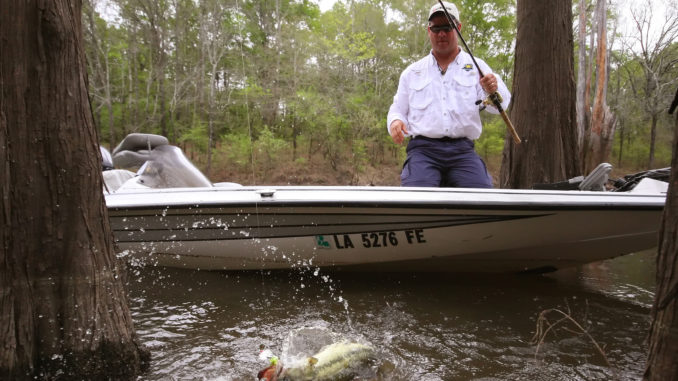
Anglers in northeast Louisiana don’t usually think about bass fishing the Ouachita River this time of year with good reason. High water levels usually push the fish so far back into the woods that it takes a machete and a chainsaw just to get to them. That’s not the case this spring, though, as my longtime friend and I found out this weekend.
The river stage for the Ouachita River at Monroe as of Monday, March 26 is 21.6-feet. That’s about 8- to 9-feet below what the level usually is this time of year. In fact, the river usually doesn’t get into the lower 20-feet range until late April or early May. And it’s prone to stay in the middle to upper 20’s at the Monroe reading through May.
“I’ve never seen the river this low this time of year,” said West Monroe angler Kenny Covington as we launched his boat at the Bawcomville SRA boat ramp. “I’ve got a little creek just to the south of hear that we should do all right in with it this low. We’ll fish the first 200-yards or so, and that should give me a good idea as to what they’re doing.”
We arrived at the mouth of Cheniere Creek just a short ride from the ramp. Covington immediately noticed how good the water looked, and he mentioned that we should be able to catch a few on a Rattlin’ Rouge or a spinnerbait. The most telling sign that foreshadowed what was to come was a few almost unnoticeable swirls along the bank.
I started out twitching a chrome/black Rouge under the surface with a typical twitch – twitch – pause retrieve. Covington had told me to try some different retrieves until we got a bite, but I continued to fish the Rouge in typical robot fashion. Covington didn’t notice my mechanical retrieve, though, because he was too busy slinging a small Mr. Hootie spinnerbait around stumps, logs and cypress trees.
“Chris Ginn, if you keep fishing that thing the same way we’ll never figure out the Rouge bite,” he admonished right before an almost imperceptible swirl to the front of the boat got his attention. “Throw it up there,” he instructed. “And don’t move it until I tell you to.”
I complied and let the Rouge sit until Covington told me to just barely twitch it without making it go under water. I didn’t even see the fish strike the lure. All I noticed was that my Rouge wasn’t on top of the water anymore. The only sound I heard was a soft slurp.
“What did I tell you,” Covington said. “That fish was in some stage of the spawn, and he didn’t want that Rouge anywhere near him. We’re going to look for the same thing the rest of the day… small swirls followed by a precise cast then a bobbling retrieve on top.”
Covington said that the Rouge bite would last all day long, but it only lasted until 12:00 for me because I had to get on the road. In that time, we caught 23 largemouth and Kentucky bass between 1- and 3-pounds. The bite was best when the sun broke free of the clouds. At least, the fish attacked our Rouges with a little less caution when the sun was out.
The only stickler for the day was that, no matter what we tried, we couldn’t make the spawning bass on the cypress trees bite. They were making huge swirls and boils, but they never attacked our Rouges. Covington tried every trick in the book, but never convinced these skittish fish to fall for it.
“The great thing about the river being this low during March is that you can go to just about any creek or river lake on this system and do the same thing,” he said. “There might be days when they want the Rouge fished a little faster or more under the water, but more often than not they’ll eat it best when you just barely twitch it on the surface.”
